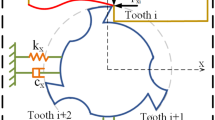Abstract
The identification of the dynamic coefficients is the key to realize accurate simulation of dynamic milling process. To enlarge the scope of dynamic simulation without ignoring edge force, an improved method is presented to calculate milling force coefficients. In this method, linear approximation of average milling force is integrated with multiple linear regressions by supposing that milling force coefficients are time invariant for small variation of feed rate. Therefore, both the shear coefficients and the edge coefficients can be calculated simultaneously. A comparison of simulated milling force with and without the edge force is illustrated and the result shows that the accuracy is higher if the edge force coefficients are considered. This method casts new light on fast and accurate simulation of the dynamic milling force in real industrial environment.
Similar content being viewed by others
References
Jianwei Dang, Weihong Zhang, Yun yang and Min Wan, Cutting force modeling for flat end milling including bottom edge effect cutting, International journal of Machine Tools & Manufacture, 50(11) (2010) 986–997.
G. Yucesan and Y. Altintas, Improved modeling of cutting force coefficients in peripheral milling, International Journal of Machine Tools & Manufacture, 34(4) (1994) 473–487.
X. P. Li, J. Q. Zheng, Y. S. Wong and A. Y. C. Nee, An approach to theoretical modeling and simulation of face milling forces, Journal of Manufacturing Processes, 2(4) (2000) 225–240.
M. Yang and H. Park, The prediction of cutting force in ballend milling, International Journal of Machine Tools & Manufacture, 31(1) (1991) 45–54.
I. S. Kang, J. S. Kim, J. H. Kim, M. C. Kang and Y. W. Seo, A mechanistic model of cutting force in the micro end milling process, Journal of Materials Processing Technology, 187/188 (2007) 250–255.
W. A. Kline, R. E. Devor and J. R. Linberg, The prediction of cutting forces in end milling with application to cornering cuts, International Journal of Machine Tool Design and Research, 22(1) (1982) 7–22.
Y. Altintas, Manufacturing automation—Metal cutting mechanics, machine tool vibrations, and CNC design, Cambridge University Press, Cambridge, UK (2000).
S. Engin and Y. Altintas, Mechanics, dynamics of general milling cutters. Part I: helical end mills, International Journal of Machine Tools & Manufacture, 41(15) (2001) 2195–2212.
A. Lamikiz, L. N. Lo’pez de Lacalle, J. A. Sa’nchez, M. A. Salgado, Cutting force estimation in sculptured surface milling, International Journal of Machine Tools & Manufacture, 44 (2004) 1511–1526.
Min Liu, Lulu Jin, Qinglong An and Ming Chen, Study on cutting force coefficients in end milling die steel $Cr16Mo, Journal of Shanghai Jiao Tong University, 43(1) (2009) 25–29.
Li Yin and Qiang Liu, Study on the identification of the milling force Parameter model based on partial least square regression and application, Mechanical Science And Technology, 24(3) (2005) 269–272.
George W. Collins, II. Fundamental numerical methods and data Analysis. Case Western Reserve University, Cleveland, USA (2003).
Donald. E. Myers, Spatial interpolation: an overview. Geoderma, 62 (1994) 17–28.
Author information
Authors and Affiliations
Corresponding author
Additional information
Recommended by Associate Editor Song Min Yoo.
Guofeng Wang is currently an associate professor in School of Mechanical Engineering, Tianjin University, China. He received his PhD degree from Tianjin University, China, in March 2002. His research interests include dynamic modeling and condition monitoring of machining process.
Rights and permissions
About this article
Cite this article
Wang, G., Peng, D., Qin, X. et al. An improved dynamic milling force coefficients identification method considering edge force. J Mech Sci Technol 26, 1585–1590 (2012). https://doi.org/10.1007/s12206-012-0306-x
Received:
Revised:
Accepted:
Published:
Issue Date:
DOI: https://doi.org/10.1007/s12206-012-0306-x



